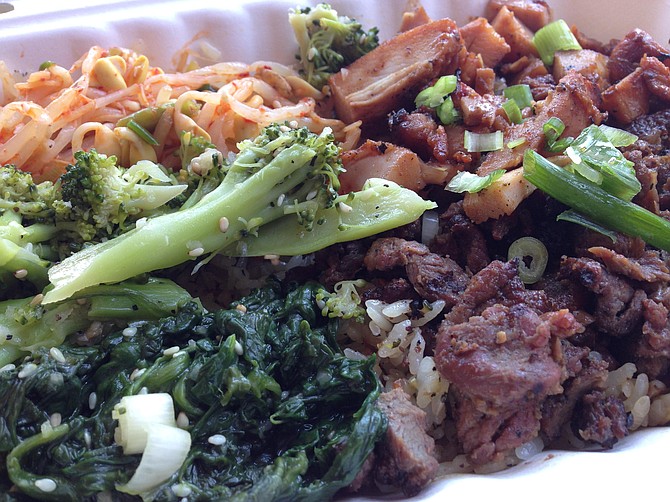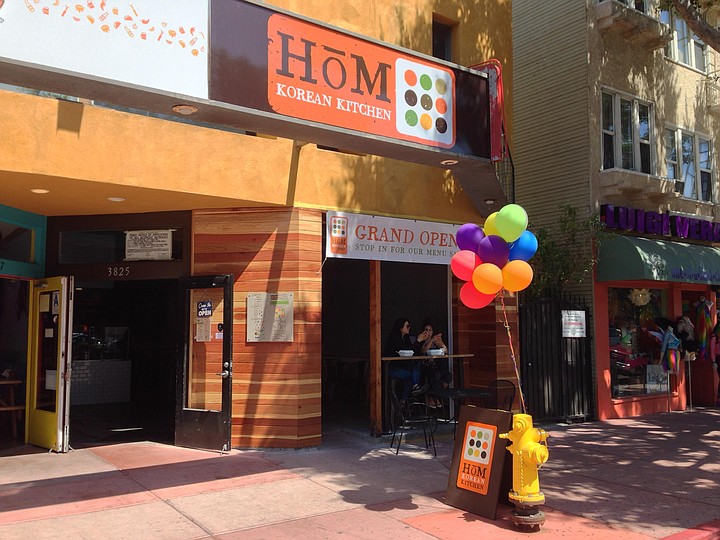 Facebook
Facebook
 X
X
 Instagram
Instagram
 TikTok
TikTok
 Youtube
Youtube

I’m not sure what the actual distinction is between fast-food and fast-casual restaurants, but I’m inclined to believe that if broccoli is served it’s better at the latter. At least, that was my thinking going in to Hōm Korean Kitchen, a San Jose shop that recently opened a location in Hillcrest.
It takes over a former fast-food sandwich shop Which Wich, and structurally the place remains the same. You custom order your Korean, bibimbap-style rice bowl at a cafeteria-style counter, and the ingredients are spooned out of metal bins, à la Chipotle.

In fact, Chipotle is often cited on Hōm’s Yelp page, which is suspiciously loaded with chipper five star reviews. One “elite”-level Yelper explains that Hōm is “Like chipotle but instead of bland Mexican food, they have tasty Korean food.” Another elite writes, “It brings Korean flavor full force. It’s almost like a Korean Chipotle.”
Phony reviews or not, Hōm is pretty bad. Not as bad as microwave-your-burger-patty fast food joints, but it’s far from great. The staff is friendly and helpful and the dining room is polished and clean, but the Korean-styled dishes served out of the shop’s working kitchen are a big letdown.
One of those elite yelpers had the audacity to write, “I’ve eaten so many Korean food throughout my life and I gotta say, this place is authentic.” Well, I’ve eaten Korean food only half of my life, and this is about as authentic as an injection of botox.
The menu is clearly aimed at popularizing Korean food to an American audience. Rather than list its meat offerings by name — bulgogi, for example — it offers “Korean steak” and “firecracker pork.” One term it does use is banchan, referring to the wide variety of side dishes traditionally served with Korean meals. The banchan dishes themselves are called carrots, potatoes, cucumber, etc.
Ordering goes like this: choose a rice or salad base, add a protein, and then choose three banchan. I started with toasted rice, which was interesting enough for an extra $1.25. I tasted samples of the various proteins ($6 to $9) and settled on a half-and-half mix of BBQ chicken and steak. The best endorsement I can offer? I would eat the chicken again.
For banchan I opted for spinach, bean sprouts, and broccoli. I love these veggies, and in my experience banchan is one of the tastiest vegetable recipes on earth. These were truly awful, enough to justify the disdain of every picky five-year-old who ever went to bed without dessert. Especially the broccoli. Somehow Hōm managed to take a naturally bitter vegetable and make it more bitter. It would have tasted better raw or steamed without any seasoning whatsoever. I appreciate side dishes that aren’t fried, but across the board these vegetables ruined a meal that was already mediocre at best.
I can get behind the spirit of sharing the glory of Korean BBQ with a mass U.S. audience. Korean cuisine should be celebrated, beloved, and available in every neighborhood, even if only through a fast-casual concept. But not like this.


I’m not sure what the actual distinction is between fast-food and fast-casual restaurants, but I’m inclined to believe that if broccoli is served it’s better at the latter. At least, that was my thinking going in to Hōm Korean Kitchen, a San Jose shop that recently opened a location in Hillcrest.
It takes over a former fast-food sandwich shop Which Wich, and structurally the place remains the same. You custom order your Korean, bibimbap-style rice bowl at a cafeteria-style counter, and the ingredients are spooned out of metal bins, à la Chipotle.

In fact, Chipotle is often cited on Hōm’s Yelp page, which is suspiciously loaded with chipper five star reviews. One “elite”-level Yelper explains that Hōm is “Like chipotle but instead of bland Mexican food, they have tasty Korean food.” Another elite writes, “It brings Korean flavor full force. It’s almost like a Korean Chipotle.”
Phony reviews or not, Hōm is pretty bad. Not as bad as microwave-your-burger-patty fast food joints, but it’s far from great. The staff is friendly and helpful and the dining room is polished and clean, but the Korean-styled dishes served out of the shop’s working kitchen are a big letdown.
One of those elite yelpers had the audacity to write, “I’ve eaten so many Korean food throughout my life and I gotta say, this place is authentic.” Well, I’ve eaten Korean food only half of my life, and this is about as authentic as an injection of botox.
The menu is clearly aimed at popularizing Korean food to an American audience. Rather than list its meat offerings by name — bulgogi, for example — it offers “Korean steak” and “firecracker pork.” One term it does use is banchan, referring to the wide variety of side dishes traditionally served with Korean meals. The banchan dishes themselves are called carrots, potatoes, cucumber, etc.
Ordering goes like this: choose a rice or salad base, add a protein, and then choose three banchan. I started with toasted rice, which was interesting enough for an extra $1.25. I tasted samples of the various proteins ($6 to $9) and settled on a half-and-half mix of BBQ chicken and steak. The best endorsement I can offer? I would eat the chicken again.
For banchan I opted for spinach, bean sprouts, and broccoli. I love these veggies, and in my experience banchan is one of the tastiest vegetable recipes on earth. These were truly awful, enough to justify the disdain of every picky five-year-old who ever went to bed without dessert. Especially the broccoli. Somehow Hōm managed to take a naturally bitter vegetable and make it more bitter. It would have tasted better raw or steamed without any seasoning whatsoever. I appreciate side dishes that aren’t fried, but across the board these vegetables ruined a meal that was already mediocre at best.
I can get behind the spirit of sharing the glory of Korean BBQ with a mass U.S. audience. Korean cuisine should be celebrated, beloved, and available in every neighborhood, even if only through a fast-casual concept. But not like this.
Comments